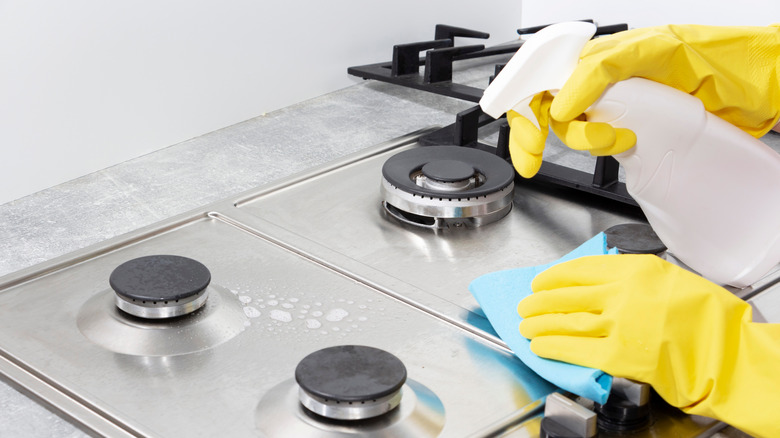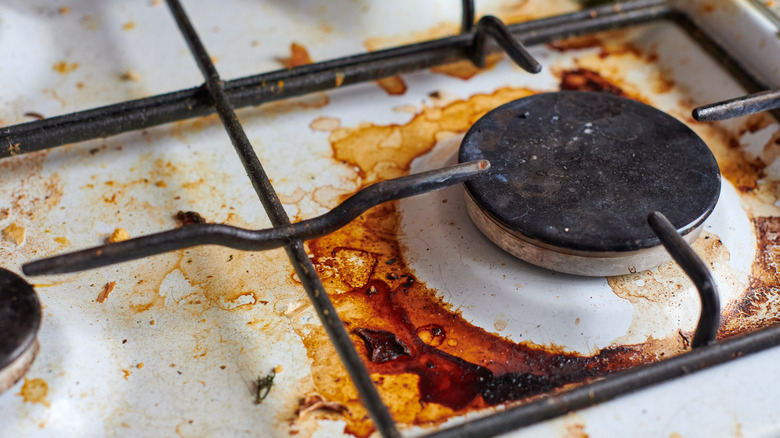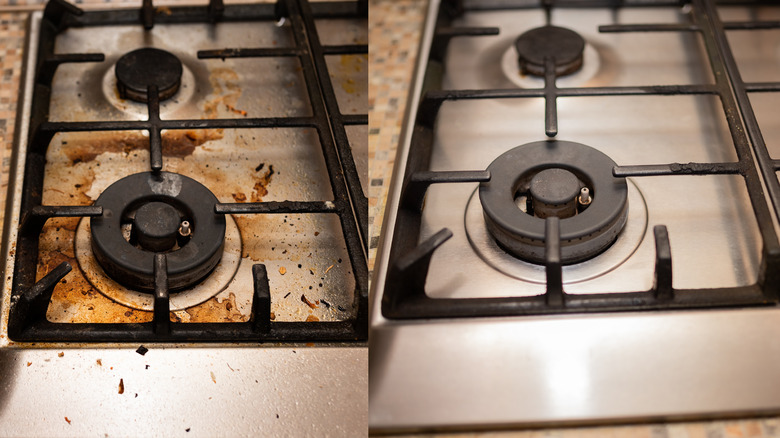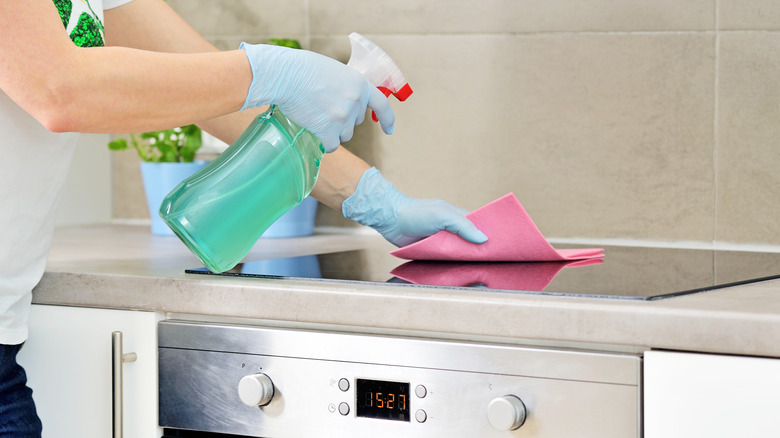How You Should Really Clean Your Stove Burners
Fortune favors the bold, and the kitchen is no exception. Julia Child said, "The only real stumbling block is fear of failure. In cooking, you've got to have a what-the-hell attitude" (via Today).
Maybe that's why some of our kitchens look like warzones after dinner is prepared. If you've ever used the word "deconstructed" to describe some of your less-than-stellar kitchen results or if you keep a chair or a broomstick strategically positioned beneath the smoke detector, you know what we're talking about here.
Add that surprise ingredient! Recipe, who? Never heard of him. This sort of Avante Garde approach to cooking can earn you some serious successes that would even make Julia Child proud. But, it can also wreak havoc on a clean kitchen. If your stove has become an unwitting casualty in your battle against boring cooking, here are some tried-and-true methods of getting it clean for round two.
Clean your stove after every use
Even if you're a by-the-book home cook, stovetops tend to get a little neglected.
Philip Tierno Jr., a clinical professor of microbiology and pathology at the NYU School of Medicine, told NBC that those uncleaned spills and food splatters can become a good medium for the growth of bacterial microbes. For this reason, it's a good idea to give your stovetop a thorough wipe down after each use.
Dirty burners aren't just a health risk, they're also a safety hazard. Cleaning professional group The Maids caution that built-up food, full grease trays, and dirty gas burner grates age the appliance and present a fire hazard. To be safe, it recommends checking gas burners for irregular flame patterns and yellow flames — indicators of an impending grease fire. If everything looks normal, The Maids suggest doing a thorough clean of your burners once a month.
Cleaning gas burners
Although they are a favorite of chefs(per Perfect Stove), there are a drawbacks to gas stoves – especially on cleaning day.
Before you dive in, make sure the stove is turned off and those burners are completely cool. This Old House says that, unlike electric stoves, gas stoves have four distinct parts that need to be cleaned individually: the grates, burner caps, burner heads, and the actual stovetop surface. After disassembling, it suggests soaking all the removable parts in hot, soapy water and letting these components soak for at least fifteen minutes. Once the food matter has softened, use steel wool, an old toothbrush, and vinegar to scrub away any lingering remains. The burners can be reassembled after they are dried and polished with lint-free fabric cloth.
Stove manufacturer Compact Appliance proposes something a little stronger to make those burners sparkle: ammonia. For best results, it says to place the burners in a sealable bag, add a few teaspoons of ammonia, seal it shut, and leave the bag on the porch or outside overnight.
The DIY blog Practically Functional suggests a middle-ground approach between chemicals and plain soap. It advises making a cleaning mixture of baking soda and hydrogen peroxide. Pour a half cup of baking soda into a small bowl, then slowly mix in enough hydrogen peroxide to turn the solution into a thin paste, it says. This paste can then be applied directly to the dirty burners and scrubbed with a scrub brush.
Cleaning electric glass burners
If you work with an electric glass stovetop, your burners are likely going to be decidedly easier to clean.
For daily maintenance, Home Depot recommends spraying a glass stove top with distilled white vinegar and wiping it with a microfiber cloth. Every other week, though, it says you should put in some more elbow grease.
On her YouTube channel Clean My Space, Melissa Maker offers a method for when it's time for a more thorough clean on your glass stove burners. To do it, soak two dish rags in a bowl of all-purpose soap and hot water. Then, while they're soaking, sprinkle baking soda directly onto the stovetop. Wring the soaked rags out about halfway, then lay them on the stovetop. After about fifteen minutes, then wipe the stovetop clean with a sponge. You can even polish the stovetop with a microfiber cloth as a finishing touch, she says.
If any stubborn food matter remains, Home Depot recommends carefully using a razor or razor scraper to remove it. But, it's a good idea to check your appliance's user manual first, to avoid scratching your stove's surface. Pro Housekeepers explains you should exercise extra caution when scrubbing away at a glass stovetop burner. It advises home cooks to avoid scrubbing brushes, steel wool, Magic Erasers, and other abrasive cleaning equipment, which can all scratch the glass's fragile surface. Stick with a microfiber cloth or a soft sponge whenever possible.



